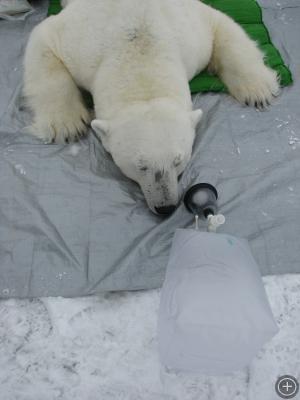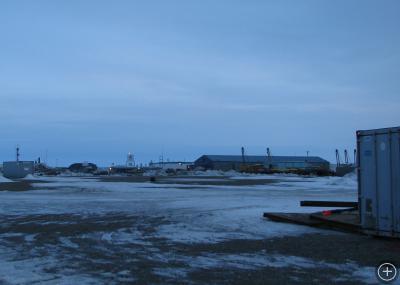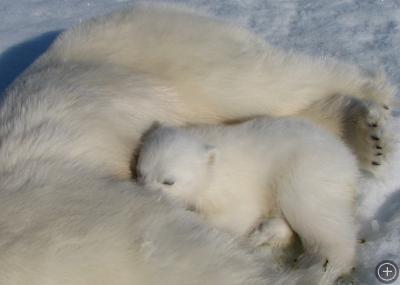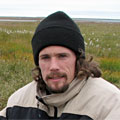Returning Home
LARAMIE, WYOMING– During last week, the weather steadily turned from cold and overcast to warm and sunny. On the first day of good conditions we launched in the morning and captured a bear shortly thereafter. After the capture we were nearing Deadhorse in the helicopter to refuel when a warning lit for the main rotor transmission. We had no problem getting home, but then we were grounded until we could get a new transmission and an additional mechanic for installation. It was frustrating to have waited out bad weather only to be grounded as the skies cleared. Mechanical problems are difficult to avoid; we already had needed a new battery and a door repair. Our second helicopter returned to refuel as well and we made new plans: we would continue capturing from a single aircraft, with reduced personnel and gear. We kept essential gear but reduced sampling equipment to a minimum. Unfortunately we did not encounter another bear that day. The parts and mechanic were on the next flight to Deadhorse and amazingly, the new transmission was in and the check flight was completed by mid-afternoon the next day.
Temperatures climbed into the 30s and 40s (Fahrenheit) and the skies continued to clear, allowing us several long days of excellent flying. Tracking conditions had been poor because sunlight becomes quite flat with low overcast skies, making it difficult to see tracks. Clear skies and direct sunlight made tracks easier to see. However, after several days the warm temperatures began to melt out all tracks, making it difficult to distinguish fresh tracks from new tracks.

Following a trail of polar bear tracks on the sea ice. To find bears for capture, we fly low over good habitat – areas of sea ice with cracks and leads which allow seals to surface, making them vulnerable to predation – and look for bears or their sign. In good light conditions such as this photo, tracks are easy to see. These tracks belonged to an adult female with two cubs-of-the-year (COYs).
We captured several sows with cubs, and an adult female and an adult male that were most likely a breeding pair. As we have all season, we fitted some of these bears with GPS collars which periodically record time, date, location, ambient temperature, bear activity, and salt water immersion (as a record of swimming). This data is stored on the collar and it is transmitted to satellite twice per day, allowing us to track the bear in real-time. We will use these collars to locate bears for recapture in the fall. For the possibility that we may not be able to recapture some bears, the collars are programmed to release in November and fall off the animal.

An adult male bear, positioned on the pads used for BIA, with the mask and bag used for breath collection.
During this last week, I thought about how brutal this environment would be for any living thing that was not prepared. The sea ice and tundra is a beautiful, intriguing area, and I really enjoy spending time here. However, I know I am out of place. For example, I usually carry some kind of emergency fire-starter while doing field work (thankfully, I have not used it). But here, there is almost nothing to burn – some driftwood pokes out of the snow along the coast, but there is nothing on the sea ice. I enjoy cold, snowy regions and I have spent a lot of time doing winter field work and skiing, and the Arctic is quite different than anywhere else I have been. The environment makes the cultures which have thrived up here all the more interesting.
Sea ice breakup continued. One day we flew about 140 miles northeast of Deadhorse to look for bears and on the return flight, we encountered a new lead of open water that looked to be over a mile wide – it had opened that afternoon. Our pilot calculated the ice in the area was moving about a third of a mile per hour.

We counted nearly 100 seals along a single crack in the ice; 10 are pictured here. They hauled out through the crack onto the sea ice to rest and breathe. Seals do not stray far from their holes; if a polar bear approaches they can quickly escape back into the water.
Our last flight day arrived quickly. We flew in the morning but did not find any bears, then returned to Deadhorse to begin packing up. For over a month, I had woken up every day prepared to fly and to work with polar bears and it was surprising how quickly everything changed. We broke down all of the lab equipment, packed it into crates, and cleaned the living space. Over three days our research team departed on the daily flights to Anchorage. I was the last to leave on Friday evening, turning down the heat in the living space, turning off the lights, and locking the doors behind me.
I landed in Anchorage for an overnight layover and it felt like stepping into a different world. The northern coast of Alaska is treeless and it was still coated with ice and snow, while Anchorage, on the south-central coast, seemed to be teeming with green trees and summer warmth. From Anchorage, I flew to Seattle then Denver, took a bus to Fort Collins, and finally got a ride to Laramie. I am glad to be home.

The sun will be above the horizon in Deadhorse until late July. One day last week we flew all day and had several captures. I finished my labwork at about 2am and I took this picture (without using a flash) of Deadhorse as I left the lab. This twilight is as dark as it got, and by mid-summer the skies will be bright through the night.











Welcome home!
So do the seals hear the polar bear…smell the polar bear or see the hungry bear?
John, I’m interest in your knowledge of what is happening to the King of the arctic, polar bears and thank you for your dedication to their study and information you’ve published on this site. I’m ignorant to how adaptable mammals are and fear the bears won’t survive the changing climate. I have questions and would appreciate your response.
On Cable TV, BRAVO channel I see these dramatic commercials put out by the Natural Resources Defense Council about the bears starving and drowning and wonder if they’re merely motivated to profit from the plight of the bears or are their alleged efforts to fight the US Government to “give the polar bear and its Arctic habitat full-fledged protection” a worthy cause?
Are these bears starving? Is it because they can no longer find food? Has their food source died off or migrated too far away from them? Are they drowning?
Is there an increase in bears looking for food around human habitats? I read a story of a researcher in Svalbard, Sweden just recently had to kill a polar bear whom had nothing in his stomach. http://www.adn.com/life/alaskana/story/845908.html
I find this all very sad and disturbing and would like to help any way I can–what can someone like me do? Thanks for your time.
Hi John! Remember me from the LTR helo course in Alaska? I was looking up some old Ice Stories dispatches about our 2008 field season in Greenland (www.uvm.edu/greenland) and came across you and your bears. Hope your work is going well, good luck with everything!
Hi Coo,
Thanks for the question. It is true that some non-profit environmental organizations put out advertisements that are quite dramatic. In the interest of full disclosure, our project is principally funded by the National Science Foundation, but we have received limited support from World Wildlife Fund (WWF), an organization that has a focus on polar bear conservation.
The main threat to polar bears is loss of sea ice due to climate change. Polar bears rely on sea ice for traveling, hunting, and in some places, digging dens and giving birth. Arctic sea ice is declining in extent. Every year the ice melts during the summer and refreezes during the winter – this is a normal pattern. However, currently, every summer the melt is becoming greater. This means that polar bears can spend less time on the ice, and the ice may not be found in areas where it once was. This can prevent bears from traveling, hunting, and in some places, digging dens.
It is impossible to be sure how bears will be affected by the loss of sea ice. However, there is a high probability that polar bears will be strongly negatively affected, and some effects are already occurring. For example, a recent study found that the population of polar bears in western Hudson Bay, Canada, declined by 22% from 1984 to 2004, and that the decline was closely associated with earlier breakup of sea ice in the spring (Regehr et al. 2007; see citations below). Similarly, a recent US Geological Survey study concluded that climate change and reduced sea ice could lead to the loss of 2/3 of the world’s polar bears in the next 50 years (USGS 2007).
It does not seem to be that the food sources of polar bears are dying off, but rather that the distribution of the bears and the food sources are changing, making it harder for polar bears to find their food items.
As the summer ice melt becomes more dramatic, polar bears in some places may be forced to spend more time on shore. Their main prey are seals, which generally aren’t found on shore, thus, the bears may eventually starve. We are not sure how long polar bears can go without food (this is one question we are studying). Some polar bears follow the ice north during the summer, but if the ice melts too far to the north over deep water, seals may not follow the ice. Thus, bears on the ice may face a similar situation as those on land. A recent study in northwestern Canada found that polar bears captured in 2005-06 were more likely to be fasting (going without food) than those that were captured in 1985-86 (Cherry et al. 2009).
Currently, it is not clear whether polar bears are drowning more frequently because of the loss of sea ice. There have been some well-publicized cases of bears seen drowning in open water, but there is not enough data to draw strong conclusions. It is probable that reduced sea ice will cause bears to swim more often and for longer distances. However, polar bears often walk and swim over huge distances, and it is difficult to ascertain whether they are swimming more and if this presents a danger.
It is also probable that as polar bears have more difficulty finding food items, they will look for food around human habitats more often. A recent study concluded that increases in bear encounters in some parts of Canada were likely related to food-stressed bears seeking items to eat (Stirling and Parkinson 2006).
Overall, although many questions remain it is clear that climate change and the loss of sea ice present a serious danger to polar bears, and it is likely that polar bear populations will continue to decline. A summary of how bears will likely be affected by loss of sea ice is presented by Derocher et al. (2004).
Because I am in a scientific position, it is difficult to recommend any specific conservation action, such as supporting a particular environmental group or practice. However, I will say that climate change is a very real problem, and it has very serious implications. To me, the heart of the issue seems to be how we generate the power that runs everything from cars to toasters, and how we use or abuse that power. Internationally-coordinated efforts are needed, but so are individual actions. Climate change is a human problem that is affecting the world, and every individual that recognizes the problem and addresses it in their life will make a difference.
Take care,
John
Citations:
Regehr, Lunn, Amstrup, Stirling. 2007. Effects of earlier sea ice breakup on survival and population size of polar bears in western Hudson Bay. Journal of Wildlife Management 71:2673-2683.
USGS (US Geological Survey). 2007. USGS Science to Inform U.S. Fish & Wildlife Service Decision Making on Polar Bears, Executive Summary.
Cherry, Derocher, Stirling, Richardson. 2009. Fasting physiology of polar bears in relation to environmental change and breeding behavior in the Beaufort Sea. Polar Biology 32:383-391.
Stirling, Parkinson. 2006. Possible effects of climate warming on selected populations of Polar Bears (Ursus maritimus) in the Canadian Arctic. Arctic 59:261-275.
Derocher, Lunn, Stirling. 2004. Polar bears in a warming climate. Integrative and Comparative Biology 44:163-176.
Hi Lee – I sure do remember you, hope your Greenland work is going well! Thanks!
Hi Gordy – that is a good question. I am looking for a mammal book that describes the senses of a seal. I would imagine sight and sound are pretty important, but I hope to figure it out soon.